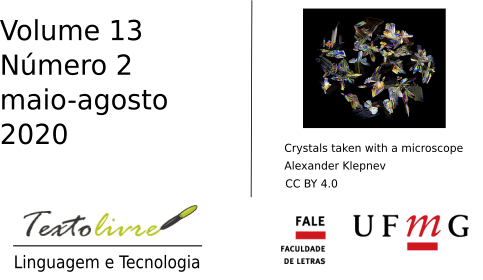Sing and learn
analysis of the reception of a virtual language teaching tool
DOI:
https://doi.org/10.35699/1983-3652.2020.24389Keywords:
Sing and learn, CALL, Learning strategiesAbstract
Digital information and communication technologies are present in our daily lives at all times, and they also have an influence on foreign language teaching-learning processes by providing authentic material and real audience to learners. The virtual tool Sing and Learn is a lyric-based English language study website, which not only provides listening comprehension exercises, but also offers vocabulary, grammar, reading and writing practice to instigate students to use different learning strategies (MORAES, 2017). The present work then seeks to analyze from the concept of learning strategies (OXFORD, 1990; 2003) a lesson performed in Sing and Learn, as well as the reception of the mentioned tool by university students. Thus, the research data was obtained through a virtual questionnaire applied to students of an Instrumental English discipline after completing the lesson. As a method of data analysis, a classification was built, based on Saldaña (2012), using codes for the answers given by students to the open questions proposed in the questionnaire. The results of the study show an acceptance of the tool by the learners, verifying that it has a lot to contribute to the teaching-learning of English language.
Downloads
References
BECK, R. J. What Are Learning Objects? Center for International Education. 2001. Disponível em: http://www4.uwm.edu/cie/learning_objects.cfm?gid=56. Acesso em: 23 nov. 2019.
BERNARD, H. R. Research Methods in Anthropology: Qualitative and Quantitative Approaches. Fifth Edition. New York: Altamira Press, 2011.
BOOTHE, D.; WEST, J. English Language Learning through Music and Song Lyrics – The Performance of a Lifetime. International Conference: The Future of Education, Edition 8. 2018. p. 1-5. Disponível em: https://conference.pixel-online.net/FOE/files/foe/ed0005/FP/0475-ITL949-FP-FOE5.pdf. Acesso em: 23. nov. 2019.
BRAGA, J. de C. F.; SILVA, L. de O.; JUNIOR, R. C. G. CALL & MALL: using technology to achieve educational objectives in the language classroom. In: OLIVEIRA, A. L. A. M.; BRAGA J. de C. F. (org.). Inspiring insights from an English Teaching Scenes. Belo Horizonte: CEI – Curso de Especialização em Ensino de Inglês FALE/UFMG, 2017. p. 121-141.
COSTA, E. S. da. Sing and Learn: Sistema de ensino de inglês através de músicas. 2018. (Trabalho de Conclusão de Curso em Sistemas de Informação) - Universidade Luterana do Brasil, Canoas, 2018.
BUTLER-PASCOE, M. E.; WIBURG, K. M. Technology and teaching English language learners. Boston: Pearson Education, 2003.
ELLIS, R. Task-based Language Learning and Teaching. New York: Oxford University Press, 2003.
ENGH, D. Why Use Music in English Language Learning? A Survey of the Literature. English Language Teaching, v. 6, n. 2, p. 113-127, 2013.
FARDO, M. L. A gamificação aplicada em ambientes de aprendizagem. Novas Tecnologias na Educação-CINTED-UFRGS, Porto Alegre, v. 11, n. 1, p. 1-9, jul. 2013.
GARRET, N. Computer-Assisted Language Learning Trends and Issues Revisited: Integrating Innovation. The Modern Language Journal, v. 93, p. 719-740, 2009.
GRIFFITHS, C.; CANSIZ, G. Language learning strategies: An holistic view. Studies in Second Language Learning and Teaching, v. 5, n. 3, 2015. p. 473-493.
HODGINS, H. W. The future of learning objects. e-Technologies in Engineering Education: learning outcomes providing future possibilities. In: LOHMANN, J.; CORRADINI, M. (eds.). ECI Symposium Series. v. P01, 2002. p. 76-82. Disponível em: https://dc.engconfintl.org/etechnologies/11/. Acesso em: 23 nov. 2019.
HUBBARD, P. Mini-course: An Invitation to CALL. Foundations of Computer-Assisted Language Learning. Unit 1: Introduction to Computer-Assisted Language Learning. Linguistics Department – Stanford University. 2016. Disponível em: https://web.stanford.edu/~efs/callcourse2/CALL1.htm. Acesso em: 23 nov. 2019.
LANKSHEAR, C.; KNOBEL, M. Sample ‘the new’ in New Literacies. In: LANKSHEAR, C.; KNOBEL, M. (org.). A New Literacies Sampler. New York: Peter Lang Publishing, 2007, v. 29. p. 1-24.
LYRICSGAPS. Lyrics gaps. Disponível em: https://www.lyricsgaps.com/. Acesso em: 02 mar. 2020.
LYRICSTRAINING. Lyrics training. Disponível em: https://lyricstraining.com/. Acesso em: 02 mar. 2020.
MARTINS, C. B. M. J.; MOREIRA, H. O campo CALL (Computer Assisted Language Learning): definições, escopo e abrangência. Calidoscópio, Vol. 10, n. 3, p. 247-255, set/dez 2012.
MORAES, M. de M. Working with songs beyond listening practice – The creation of a language learning tool. 2017 (Trabalho de Conclusão de Curso de Licenciatura em Letras) – Universidade Federal do Rio Grande do Sul, Porto Alegre, 2017.
MORETI, A; ALONSO, M. Dealing with Songs through the Four Skills. Revista Científica de Letras. Franca, São Paulo. v. 5, n. 5, p. 85-112, 2009.
MURPHEY, T. Music and Song. Oxford. 1992a.
MURPHEY, T. The Discourse of Pop Songs. TESOL Quarterly, v.26, n.4. p.770-774, 1992b.
OXFORD, R. L. Language Learning Strategies: What Every Teacher Should Know. USA: Heinle & Heinle Publishers, 1990.
OXFORD, R. L. Language Learning Styles and Strategies: an Overview. Learning Styles & Strategies. Oxford: Gala, p. 1-25, 2003.
ROJO, R. Between Platforms ODAs and Prototypes: New multiliteracies in WEB2 times. The ESPecialist: Descrição, Ensino e Aprendizagem, v. 38, n. 1, p. 1-20, 2017.
SALDAÑA, J. The coding manual for qualitative researchers 2nd ed. Thousand Oaks, CA: Sage, 2012.
SINGANDLEARN. Sing and Learn. Disponível em: http://www.singandlearn.com.br/. Acesso em: 02 mar. 2020.
VILAÇA, M. L. C. Classificação de Estratégia de Aprendizagem de Línguas: Critérios, Abordagens e Contrapontos. Revista Eletrônica do Instituto de Humanidades. n. 36, p. 43- 56, 2011.
WARSCHAUER, M.; HEALEY, D. Computers and Language Learning: an overview. State of the art article, United Kingdom, p. 57-71, 1998. Disponível em: http://hstrik.ruhosting.nl/wordpress/wp-content/uploads/2013/03/Warschauer-Healey-1998.pdf. Acesso em: 23 nov. 2019.
WILEY, D. A. Connecting learning objects to instructional design theory: a definition, a metaphor, and a taxonomy. In: WILEY, D. A. (Ed.). The instructional use of learning objects: Online Version. 2002. Disponível em: https://pdfs.semanticscholar.org/03fe/e95ed98d8dc262ccd363a589a235db91e331.pdf?_ga=2.176406821.1805027650.1586484294-1431907872.1586484294. Acesso em: 10 mar. 2019.
Downloads
Published
How to Cite
Issue
Section
License

This work is licensed under a Creative Commons Attribution 4.0 International License.
This is an open access article that allows unrestricted use, distribution and reproduction in any medium as long as the original article is properly cited.











